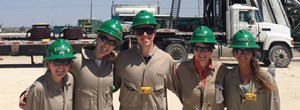Fewer than 20% of U.S. shale oil jobs held by women, says trade group
HOUSTON (Bloomberg) - Gender diversity remains a challenge in the U.S. shale patch, where fewer than two of every 10 jobs are held by women, according to the latest study by a trade group representing the hired hands of the oil field.
Since an initial study in 2018, when 16% of oilfield-service and equipment-maker jobs were held by woman, that share has climbed three percentage points. However, it falls short of an industry goal set three years ago to employ 20% of its workforce with women by 2020, according to the Energy Workforce & Technology Council.
“We’ve made progress in the last three years,” Molly Determan, the chief operating officer at the Workforce Council who led the study, said in a phone interview. “Although it is encouraging, we do still have a lot of work to do.”
The oilfield service sector, which helps shale explorers map pockets of underground crude and drill new wells, has been among the most beaten up areas of the industry since the global pandemic led to an historic slump in crude prices. After more than 100,000 service and manufacturing jobs were cut in the U.S. oil patch last year, oilfield contractors have begun to slowly bring workers back. But they’re having a hard time raising prices for their work enough to boost profits.
“As they’re looking to re-hire and they’re trying to build back up their workforce, it’s hard for small companies especially to really focus on things like even having a diverse candidate pool to work from,” Determan said.
The biggest areas of improvement, according to the study, include putting more women in leadership roles, as well as offering mentoring programs and more incentives like flexible work arrangements.
The study, which was done in partnership with Accenture Plc, surveyed 25 large and small oilfield service companies globally that have a combined 250,000 workers. In addition to tracking female employment, the study for the first time established a benchmark for racial diversity among service companies, where a quarter of the U.S. workforce is made up by minorities.
The study didn’t specifically address the number of females working in field roles versus office jobs, and the challenges that field work can represent to hiring. Schlumberger, the world’s biggest oilfield service provider, said earlier this year that a survey of its female workers found that more than half couldn’t go to work in the oil fields at some point because there weren’t facilities available for them there.
“Working in the field, we realize there is a challenge in recruiting women into those positions,” Determan said. “Our companies are definitely committed to making sure that they’re in an environment where they feel safe and comfortable having those positions.”



